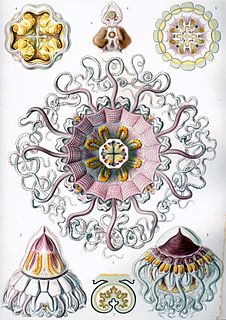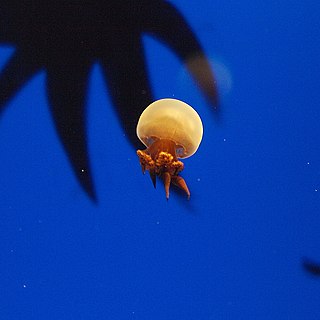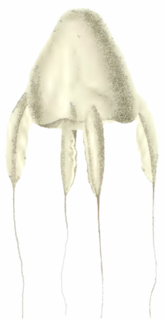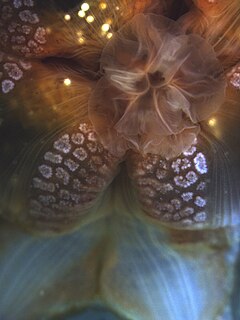
Rhizostomae or Rhizostomeae is an order of jellyfish. Species of this order have neither tentacles nor other structures at the bell's edges. Instead, they have eight highly branched oral arms, along which there are suctorial minimouth orifices. These oral arms become fused as they approach the central part of the jellyfish. The mouth of the animal is also subdivided into minute pores that are linked to coelenteron.

Cassiopea is a genus of true jellyfish and the only members of the family Cassiopeidae. They are found in warmer coastal regions around the world, including shallow mangrove swamps, mudflats, canals, and turtle grass flats in Florida, and the Caribbean and Micronesia. The medusa usually lives upside-down on the bottom, which has earned them the common name. These jellyfish partake in a symbiotic relationship with photosynthetic dinoflagellates and therefore, must lay upside-down in areas with sufficient light penetration to fuel their energy source. Where found, there may be numerous individuals with varying shades of white, blue, green and brown.

Crown jellyfishes are the six families of true jellyfish that belong to the order Coronatae. They are distinguished from other jellyfish by the presence of a deep groove running around the umbrella, giving them the crown shape from which they take their name. Many of the species in the order inhabit deep sea environments.

Periphyllidae is a family of jellyfish containing four genera and six species. The most well-known member of the family, Periphylla periphylla, is usually considered a deep-sea species, but it forms large blooms in surface waters of Norwegian fjords.

Rhopilema is a genus of jellyfish.

Chirodropidae is a family of venomous box jellyfish within the class Cubozoa.

Atolla is a genus of crown jellyfish in the order Coronatae. The genus Atolla was originally proposed by Haeckel in 1880 and elevated to the monotypic family level, as Atollidae by Henry Bigelow in 1913. The six known species inhabit the mesopelagic zone. The medusae possess multiple lobes called lappets at the bell margin. Medusae also have eight tentacles, alternating with eight rhopalia, and twice as many lappets occur as tentacles.

Alatinidae is a family of box jellyfish within class Cubozoa, containing the following genera and species:

Lucernariidae is a family of stalked jellyfish containing two genera.

Olindiidae is a family of hydrozoans in the order Limnomedusae. They have a polyp phase and a medusa phase. The polyps are generally small (1 mm) and solitary, but a few species are colonial. They have a varying number of tentacles and can reproduce by budding. In the largest species, the medusae can grow to 15 cm (6 in). Centripetal canals may be present or absent and the radial canals are unbranched. The gonads are beside the radial canals, except in Limnocnida, where they are on the manubrium. The fertilised eggs develop into planula larvae which become polyps. These multiply asexually or can bud off medusae. In some species, medusae are only produced when the water temperature exceeds a certain level. Most species are marine, but several can also be found in brackish water and a few, notably Craspedacusta and Limnocnida, are found in fresh water.

Tamoya is a genus of box jellyfish within the monotypic family Tamoyidae.

Corynidae is a family of hydrozoans in the order Anthomedusae.

Rhizostomatidae is a family of cnidarians in the class Scyphozoa.

Catostylus is a genus of jellyfish in the family Catostylidae.

Spirocodon is a monotypic genus of hydrozoans with Spirocodon saltatrix as the only species in the genus. It is found in the north-western Pacific Ocean, and was first described in 1818 by the German naturalist and explorer Wilhelm Gottlieb Tilesius von Tilenau.

Ulmaris is a genus of jellyfish in the family Ulmaridae.
Lychnorhizidae is a family of true jellyfish.

Coronamedusae is a subclass of jellyfish in the class Scyphozoa. It is the sister taxon of Discomedusae and contains about 50 named species, all included in the order Coronatae. Jellyfish in this subclass are either small medusae living in shallow marine environments, or large medusae living in the deep sea.
Linantha is a genus of crown jellyfish in the family Linuchidae. It is a monotypic genus and the only species is Linantha lunulata which was first described by the German biologist Ernst Haeckel in 1880. It is found in the tropical eastern Pacific Ocean in the vicinity of the Galápagos Islands.

Thysanostomatidae is a family of true jellyfish from the Indo-Pacific.
















